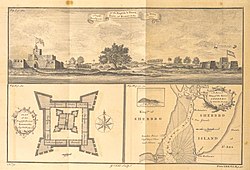History
Fort Vredenburgh was built in 1682 on the left bank of the Komenda River (Dutch Komenda). At the same site, a trading post was established by the Dutch around 1600, but abandoned soon afterwards.
Since halfway through the 17th century, the state of Komenda (a part of the Kingdom of Eguafo), was a site of fierce competition between the English, Dutch, Danish, Brandenburgish and French traders. This competition between European powers was compounded by competition between African states in the region, which concluded changing alliances with the various European powers.
The Dutch had intermittently operated a lodge at Komenda, which they extended into a fort in 1682. Still, they could not prevent Jean-Baptiste du Casse from establishing a French trade post at Komenda in 1687. Du Casse established friendly relations with the powerful local trader John Cabess, but his trading post was destroyed by the Elmina and Eguafo allies of the Dutch about a month after its establishment. In 1689, the Dutch extended their Fort Vredenburgh, but found their influence severely diminished because they had offended Cabess by driving out the French.
At the turn of the 18th century, Komenda was the site of several Komenda Wars, which involved the Dutch and the English and their respective local allies. In 1694, the English built a fort (Fort Komenda) within the range of Fort Vredenburgh on the right bank of the Komenda River (English Komenda) with the help of John Cabess.
The rivalry evidenced by the forts built within each other's reach, was as much a rivalry within the Eguafo state as it was one between the European powers. In fact, at the time of the Komenda Wars, Great Britain and the Dutch Republic were in a personal union, with both states being led by William III of Orange.
This page is based on this
Wikipedia article Text is available under the
CC BY-SA 4.0 license; additional terms may apply.
Images, videos and audio are available under their respective licenses.







